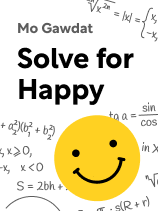

This article is an excerpt from the Shortform book guide to "Solve for Happy" by Mo Gawdat. Shortform has the world's best summaries and analyses of books you should be reading.
Like this article? Sign up for a free trial here.
Why are most people not as happy as they want to be? Is there a formula for happiness?
The modern world is rife with obstacles to happiness. Many people view happiness as an elusive goal. However, we can be consistently happy if we bring our expectations and perceptions of our lives into alignment. In Solve for Happy, Mo Gawdat outlines an algorithm to do so.
Keep reading for an overview of this encouraging book.
Overview of Solve for Happy by Mo Gawdat
As a former engineer and Chief Business Officer at Google X, Gawdat approaches the problem of happiness through an engineer’s analytical eyes. Through careful observation and refinement, he created an algorithm that made him consistently happy. After his son, Ali, died suddenly and unexpectedly in 2014, this algorithm provided reprieve amidst unfathomable pain.
In this overview of Solve for Happy by Mo Gawdat, we’ll discuss how our perceptions and expectations determine our happiness, and we’ll explain how to tip the balance of happiness in our favor using Gawdat’s algorithm, which he calls the 6-7-5 Model: Dispel six misconceptions that cause us to suffer, remove seven weaknesses that hinder our happiness, and embrace five pillars that lead us to joy.
Preliminary Assumptions About Happiness
Before we proceed to the algorithm itself, let’s discuss the key assumptions that shape it.
First, Gawdat asserts that happiness is our default state. Consequently, we’re unhappy only when abnormal reasons make us unhappy.
The Happiness Formula
To apply the algorithm for happiness, you also need to understand what factors make you happy or unhappy in the first place. To that end, Gawdat introduces the following happiness equation:
Happiness (Your perception of life’s events) – (Your expectations for life’s events)
According to this formula, you’re happy when you perceive life as exceeding your expectations and you’re unhappy when you perceive life as falling short of expectations.
Misconceptions Keep Us From Happiness
Gawdat claims that six misconceptions—he calls them “illusions”—cause suffering and prevent us from becoming happy.
Misconception 1: Our Inner Voice Is Our Self
Gawdat argues that, although we’re inclined to identify with the voice in our head, we aren’t identical to it. Gawdat asserts that this internal voice is our brain talking. The brain overemphasizes threats and replays them incessantly. By needlessly replaying these memories, your brain prevents you from being happy.
However, Gawdat argues that we can control our brain and end the suffering that our internal voice causes:
- Trace negative thoughts to their cause, and you’ll often see that they’re ill-founded. Replace these negative thoughts with positive thoughts, ideally about the same subject.
- When you need a break from thinking about a certain subject, observe your surroundings to change the subject in your brain.
Misconception 2: Our Body Is Our Self
Gawdat claims that people typically identify with their bodies. But, on the contrary, Gawdat argues that we’re non-physical observers of our bodies. Thus, the events that impact our physical bodies don’t affect our true selves.
His argument depends on what he calls the “perception test” and the “permanence test.” The perception test dictates that, if you’re able to observe an object, you’re distinct from it. The permanence test dictates that, if one of your qualities changes while you remain unchanged, you’re not identical to that quality.
Misconception 3: We Know Everything
We identify strongly with our knowledge. However, this leads to another misconception: We know it all. Instead, Gawdat argues that our knowledge is deeply limited. Gawdat points out that most of our knowledge is rooted in our senses. Yet, our senses are limited. Further, Gawdat points out that we use words to convey knowledge, but words are imperfect vehicles for truth.
Since we actually know relatively little, the misconception of knowledge distorts our expectations and makes us unhappy.
Misconception 4: Time Is Real
We tend to believe that time exists independently of us. Gawdat, however, argues against this misconception: Time isn’t an objective feature of reality.
To defend this claim, Gawdat offers two related arguments. First, he observes that the subjective experience of time differs from person to person. For instance, if you’re in the middle of a workout, you’ll perceive time as passing slowly, while your friend at a party might perceive it as passing quicker.
Second, Gawdat appeals to Einstein’s theory of relativity. Because relativity views time as malleable, Gawdat concludes that it’s incompatible with our rigid conception of time.
Instead of regretting past misfortunes and dreading future decisions, as though time were real, we can focus on what is real: the present. That will reduce suffering and increase happiness.
Misconception 5: We Control Our Lives
We tend to think we’re in control of our lives. Gawdat argues that we actually control relatively little.
In support of his claim, Gawdat appeals to Nassim Nicholas Taleb’s view, outlined in The Black Swan, that seemingly improbable events happen frequently. However, because we think they’re uncommon, we’re unprepared and forced to abdicate control when they happen.
Gawdat also appeals to the “butterfly effect,” Edward Lorenz’s theory that imperceptible shifts in a system can yield widespread consequences. Because we can’t control these shifts, our sense of control over the entire system is misguided.
Because we mistakenly feel in control, our expectations are overinflated, preventing us from solving the happiness formula.
Committed Acceptance
Nonetheless, Gawdat doesn’t recommend that we completely jettison control. Rather, he counsels what he calls “committed acceptance”: Do your best, but be detached from the consequences.
By taking this approach, you remain concerned with factors in your control while relinquishing worries over factors outside your control. In so doing, you avoid the suffering which follows from a false sense of control.
Misconception 6: Fear Protects Us
Our obsession with control stems from a fear of the unknown. This fear itself is part of a deeply ingrained misconception that fear protects us from harm. Against this misconception, Gawdat argues that fear is useless because it leaves us paralyzed and doesn’t lead us to actions needed for happiness. To dispel this misconception, we have to confront our deepest fears head-on.
However, we often don’t know our deepest fears because core fears—like rejection—are masked by layers of derivative fears—like a fear of first dates. Gawdat calls this our “safe model,” where our brain protects us from a core fear via layers of derivative fears.
Because the fears implemented by our safe model are wide-reaching, Gawdat argues that they negatively shape our expectations, causing us to expect harm at every turn. Accordingly, to bring our expectations in line with reality, we must confront our fears by asking and answering these questions:
- “What’s the worst-case scenario?”
- “Who cares if that happens?”
- “Is it likely that will happen?”
- “How do I prevent the worst from happening?”
- “Can I rebound if the worst does happen?”
- “What if I don’t face my fears?”
- “What’s the best that could happen?”
Fix Weaknesses
After dispelling the misconception that cause us to suffer, Gawdat focuses on seven weaknesses (or “blind spots, as he calls them) that cause us to be unhappy.
Weakness 1: Filters
Our first weakness stems from the overwhelming amount of information available to our brains. Most of this information is irrelevant to making decisions, so our brains filter it out. Gawdat observes that our brain focuses on negative information—that is, information that constitutes a threat. Consequently, it filters out positive information.
To repair this weakness, remind yourself that your brain filters out most available information. In turn, you can focus on uncovering positive information that your brain has kept hidden.
Weakness 2: Assumptions
There are also instances where our information is incomplete. In such instances, your brain makes assumptions to fill in the gaps. These assumptions skew our perceptions of reality and prevent us from solving the happiness formula.
To avoid such assumptions, Gawdat recommends reevaluating what you “know” and retaining only beliefs that you’ve verified with your senses.
Weakness 3: Predictions
Similarly, we tend to make assumptions about the future. Yet, Gawdat argues that these predictions are often inaccurate or self-fulfilling. First, our predictions are inaccurate because we often extrapolate from relatively few data points. Second, our predictions are often self-fulfilling because they influence our actions.
Our false predictions instill unfounded expectations and prevent us from fulfilling the happiness formula. To temper these expectations, remind yourself that your predictions aren’t infallible.
Weakness 4: Memories
Gawdat argues that memories color our perceptions by distorting the lens through which we perceive reality. After all, our memories are merely what we think happened, so they’re often inaccurate guides to the past. In turn, they lead us to misrepresent the present by projecting false conceptions of the past onto it.
To prevent faulty memories from infiltrating our present experience, Gawdat recommends noticing when we use past-tense verbs, like “heard,” “saw,” and “felt.” These verbs signal that we’re relying on our memories, so monitoring them can ensure that our memories aren’t shaping our present perceptions.
Weakness 5: Labels
Memories can be particularly harmful when they lead to labels: stereotypes of certain groups and characteristics on the basis of limited past experience. Because we extrapolate labels from limited data, they’re often inaccurate and harmful.
To minimize this harm, use extreme scrutiny when you catch yourself using a label. Often, this scrutiny will reveal that your labels are ill-founded.
Weakness 6: Emotions
Gawdat notes that, in the brain’s evolution, emotions once played a pivotal role in making necessary split-second decisions. Now that such decisions are less necessary, Gawdat argues that emotions obscure our decision-making, and we then find reasons to justify our sub-par decisions.
To remedy this weakness, Gawdat recommends listening to your inner dialogue to look for the influence of emotion. By recognizing emotions, you can prevent them from shaping your decisions.
Weakness 7: Exaggeration
Gawdat argues that, when your brain needs your attention, it exaggerates your perceptions so it can’t be ignored. In particular, our brain tends to exaggerate negative possibilities, because these pose the biggest threat to our survival.
To preempt excessive exaggeration, be wary of blanket terms, like “always,” “never,” and “certain.”
Embrace Pillars to Become Happy
Finally, Gawdat suggests that, for happiness to endure, we must embrace five pillars, which he calls “ultimate truths.”
Pillar 1: The Importance of Awareness
Gawdat’s first pillar dovetails with his previous discussion on the misconception of time, where he argued that only the present moment exists. Accordingly, his first pillar states that, to be happy, you must spend time fully aware of the present moment. In particular, cultivate presence to reach awareness.
To return to our default state of awareness, Gawdat offers several concrete strategies, such as:
- Prioritize awareness: Prioritize awareness by, for example, writing down every positive event or note when your mind drifts.
- Reduce distractions: Incorporate quiet times into your schedule, or spend time without access to your phone.
- Make a totem: Select an item that reminds you to be present. Keep this totem with you, and whenever you notice it, take a brief awareness break.
Pillar 2: The Inevitability of Change
Gawdat’s second pillar complements the misconception of control. Control is illusory, he argues, because change is constant and inexorable. Despite the inevitability of change, we attempt to control our lives and resist changes to it. Because change upends our best-laid plans, our expectations are rarely met, which makes us unhappy.
To reach lasting happiness in the face of constant change, Gawdat recommends pursuing “the path,” a concept synthesized from Buddhism, Islam, and ancient Chinese philosophy. Simply put, following the path requires letting your life reach equilibrium—the point of effortless acceptance where we no longer resist change. On a more practical level, following the path entails not pushing for extremes.
When you accept that change is part of life, you’ll find that your efforts work with change, rather than against it; you’ll be swimming with the current rather than floundering against it. Consequently, your expectations will be better aligned with reality, which allows you to consistently be happy.
Pillar 3: The Necessity of Love
Gawdat’s third pillar is that, to reach lasting happiness, you must love unconditionally.
First, Gawdat argues that unconditional love is fundamentally different from emotions like admiration and respect, which occur for reasons; we admire and respect others because of the virtues they exemplify. Unconditional love, by contrast, just happens—we don’t love unconditionally because of any traits possessed by our beloved.
He argues that, because unconditional love occurs inexplicably, we don’t expect anything of our beloved—rather, we’re simply happy to be in their presence. This lack of expectations precludes the possibility of disappointment and thus paves the path toward lasting happiness.
How to Love Unconditionally
Gawdat offers the following strategies for cultivating unconditional love:
- See past the masks that others wear.
- Love yourself.
- Give freely without expecting anything in return.
Pillar 4: The Impermanence of Death
Gawdat’s fourth pillar complements his earlier claim that, rather than being identical to our physical bodies, we’re actually immaterial beings observing the physical world. Because we’re immaterial, Gawdat argues that the death of our bodies does not end our lives; death is impermanent.
Citing the double-slit experiment in quantum physics, Gawdat asserts that the physical world exists only when it’s observed. Gawdat also appeals to the Big Bang theory. Because the theory implies the universe had a beginning, while the double-slit experiment implies the universe could exist only if it were observed, Gawdat reasons that life must have preceded the Big Bang to observe it unfolding.
Finally, because Einstein’s theory of relativity shows that our perception of time is illusory, Gawdat argues that life must exist outside of time, in four-dimensional spacetime. So, although birth and death appear to mark the beginning and end of our life, we actually transcend time. Death, therefore, simply returns us to our home outside of time.
By recognizing that the physical world is temporary and death is impermanent, we can shape our perceptions to better align with the happiness formula.
Pillar 5: The Undeniability of Design
Closely related to the impermanence of death is Gawdat’s final pillar: There is an intelligent designer who created the universe, and there’s abundant mathematical evidence for his existence.
To defend this final pillar, Gawdat argues that the alternative—materialism—is wildly improbable. Since materialism is cast as the only viable alternative to intelligent design, Gawdat notes that showing it to be very improbable is tantamount to showing intelligent design to be very probable.
Gawdat’s argument against materialism operates via analogy. He asks us to imagine a monkey with a typewriter, whose task is to type the sentence, “This short sentence can be produced with random keystrokes.” The probability that the monkey randomly types the sentence is zero. Gawdat notes that the complexity of the entire universe vastly outstrips the complexity of a 56-character sentence. But, according to materialism, the entire universe arose via randomness. If we wouldn’t believe the monkey typed the 56-character sentence by sheer chance, Gawdat concludes that it’d be exponentially more foolish to believe that the entire universe developed by sheer chance.
When we recognize this final pillar, that the universe has an intelligent designer, we can achieve lasting happiness by realizing that we’re all part of a beautiful design beyond our comprehension.

———End of Preview———
Like what you just read? Read the rest of the world's best book summary and analysis of Mo Gawdat's "Solve for Happy" at Shortform.
Here's what you'll find in our full Solve for Happy summary:
- The six misconceptions that cause us to suffer
- How to remove the seven weaknesses that hinder your happiness
- The five pillars to becoming permanently happy






